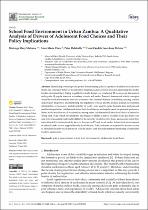| dc.contributor.author | Mukanu, Mulenga Mary | |
| dc.contributor.author | Thow, Anne Marie | |
| dc.contributor.author | Delobelle, Peter | |
| dc.date.accessioned | 2022-07-12T07:25:40Z | |
| dc.date.available | 2022-07-12T07:25:40Z | |
| dc.date.issued | 2022 | |
| dc.identifier.citation | Mukanu, M. M. et al. (2022). School food environment in urban Zambia: A qualitative analysis of drivers of adolescent food choices and their policy implications. International Journal of Environmental Research and Public Health, 19(12), 7460. https://doi.org/10.3390/ijerph19127460 | en_US |
| dc.identifier.issn | 1660-4601 | |
| dc.identifier.uri | https://doi.org/10.3390/ijerph19127460 | |
| dc.identifier.uri | http://hdl.handle.net/10566/7586 | |
| dc.description.abstract | Identifying context specific points for reforming policy to promote healthier food environments and consumer behavior in critical life stages like adolescence is crucial in addressing the double
burden of malnutrition. Using a qualitative study design, we conducted 20 focus group discussions
with grade 10 pupils from ten secondary schools in Lusaka. Turner’s framework which conceptualizes the food environment into two domains—the external domain (availability, pricing, vendor
and product properties, and marketing and regulation of food) and the internal domain (accessibility,
affordability, convenience, and desirability of food)—was used to guide thematic data analysis and
results interpretation. Adolescents stated their food choices are largely based on personal preference
linked to the need for social acceptability among peers. | en_US |
| dc.language.iso | en | en_US |
| dc.publisher | MDPI | en_US |
| dc.subject | School food environments | en_US |
| dc.subject | Adolescents | en_US |
| dc.subject | Food choice | en_US |
| dc.subject | Food security | en_US |
| dc.subject | Food policy | en_US |
| dc.subject | Lusaka | en_US |
| dc.title | School food environment in urban Zambia: A qualitative analysis of drivers of adolescent food choices and their policy implications | en_US |
| dc.type | Article | en_US |

